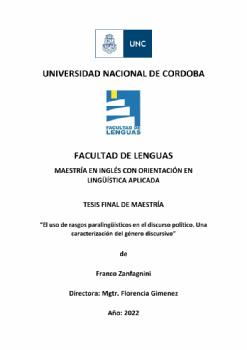| dc.contributor.advisor | Gimenez, Florencia | |
| dc.contributor.author | Zanfagnini, Franco | |
| dc.date.accessioned | 2023-03-13T13:31:47Z | |
| dc.date.available | 2023-03-13T13:31:47Z | |
| dc.date.issued | 2022 | |
| dc.identifier.uri | http://hdl.handle.net/11086/546580 | |
| dc.description | Maestría en inglés con orientación en lingüística aplicada | |
| dc.description.abstract | The present work aims to characterise political speeches considering the use of a
group of paralinguistic features (PF) taken from Brown’s (1990) taxonomy (rhetorical
pause, loudness, timing of segments, tempo), and to explore the relationships between
these vocal cues and the expression of emotions, intentions and attitudes. The sample
consisted of two presidential inaugural speeches by one female and one male speaker:
Theresa May’s 2016 inaugural and Barack Hussein Obama’s 2013 second inaugural. The
study conducted resorted to both qualitative and quantitative methods. The qualitative
analysis consisted of different steps. First, trained auditory analysis was carried out by
professional phoneticians to identify the PFs under analysis in the samples. Second, this
analysis was supplemented with acoustic measures using PRAAT (Boersma & Weenink,
2021). Third, the trained analysts proceeded to make a situated interpretation of the
emotions the speakers were believed to convey through the use of those vocal cues.
Quantitative information was obtained when the frequency of occurrence of each of the
PFs analysed and of the different emotions were calculated. Finally, associations between
the PFs in focus in this study and the attitudes, emotions or intentions detected were
established. A preliminary hierarchy of PFs derived from the analysis. The rhetorical
pause is the most frequently used PF in the political speeches analysed. As regards the
relationships between the PFs analysed and the expression of emotion, the data yielded
contradictory results. From the data gathered and the results obtained, this work explored
the pedagogical implications for the teaching and learning of PFs when reading aloud
political speeches at university level in EFL contexts such as the School of Languages,
UNC. | es |
| dc.language.iso | eng | es |
| dc.rights | Atribución-NoComercial-CompartirIgual 4.0 Internacional | * |
| dc.rights.uri | http://creativecommons.org/licenses/by-nc-sa/4.0/ | * |
| dc.subject | Phonetics | es |
| dc.subject | Fonética inglesa | es |
| dc.subject | Teaching PFs | es |
| dc.subject | Enseñanza de Lenguas Extranjeras | es |
| dc.title | El uso de rasgos paralingüísticos en el discurso político : una caracterización del género discursivo | es |
| dc.type | masterThesis | es |
| dc.description.fil | Fil: Zafagnini, Franco. Universidad Nacional de Córdoba. Facultad de Lenguas; Argentina. | es |





